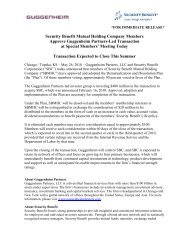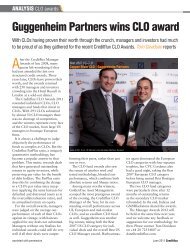THE CORE CONUNDRUM - Guggenheim Partners
THE CORE CONUNDRUM - Guggenheim Partners
THE CORE CONUNDRUM - Guggenheim Partners
Create successful ePaper yourself
Turn your PDF publications into a flip-book with our unique Google optimized e-Paper software.
Nominal Total Return<br />
Era of “Return-Free Risk”<br />
U.S. 10-Year Treasury One-Year Holding Period Returns<br />
15%<br />
10%<br />
A 20 basis point move in<br />
rates wipes away the total<br />
return in 10-year Treasuries<br />
5%<br />
0%<br />
-150 -100 -50 0 100 150 200<br />
-5%<br />
-10%<br />
-15%<br />
-20%<br />
Change in Interest Rates (Basis Points)<br />
U.S. 10-Year Treasury One-Year Holding Period Total Returns<br />
Purchasing 10-year Treasuries at current yields comes with considerable duration risk. Today’s low<br />
coupon rates mean a 20 basis point rise in rates would lead to a negative total return over a one-year<br />
holding period. With the risk in Treasuries heavily skewed to the downside, we believe Treasuries have<br />
gone from offering “risk-free returns” to now effectively becoming “return-free risk.” Source: Bloomberg.<br />
Data as 12/31/2012. The total return scenario is calculated based on the coupon rate of 1.625% and an effective duration of 9.1.<br />
liquidity from the financial system, could a repeat<br />
of the 1950s occur? While we do not envision any<br />
sudden monetary policy shifts or a meaningful<br />
rise in rates in the near term, given where rates<br />
are today and how grossly overvalued Treasury<br />
securities have become, the risk to rates is clearly<br />
to the upside. At current coupon rates, a 20 basis<br />
point rise in rates would result in a negative total<br />
return on 10-year Treasuries over a one-year holding<br />
period. Based on the asymmetrical risk-return<br />
profile, we believe Treasuries have gone from<br />
offering “risk-free returns” to now effectively<br />
becoming “return-free risk.”<br />
The dearth of yield within traditional core fixedincome<br />
sectors has resulted in an uptick in tracking<br />
error as investors increase allocations to riskier<br />
investments, such as emerging-market bonds and<br />
high-yield debt. According to eVestment Alliance,<br />
the average tracking error for core fixed-income<br />
strategies rose to 1.09 percent over the past three<br />
years ending December 2012, compared to 0.66<br />
percent in the three-year period from 2005 to 2007.<br />
Given investors’ increased willingness to venture<br />
outside the traditional confines of core fixed-income,<br />
in the following section, we propose a more optimal<br />
method to generate attractive yields without<br />
sacrificing credit quality or extending duration.<br />
9 | COPING WITH NEW MARKET REALITIES GUGGENHEIM PARTNERS














